AMD Zen 2 Microarchitecture Analysis: Ryzen 3000 and EPYC Rome
by Dr. Ian Cutress on June 10, 2019 7:22 PM EST- Posted in
- CPUs
- AMD
- Ryzen
- EPYC
- Infinity Fabric
- PCIe 4.0
- Zen 2
- Rome
- Ryzen 3000
- Ryzen 3rd Gen
CCX Size
Moving down in node size brings up a number of challenges in the core and beyond. Even disregarding power and frequency, the ability to put structures into silicon and then integrate that silicon into the package, as well as providing power to the right parts of the silicon through the right connections becomes an exercise in itself. AMD gave us some insight into how 7nm changed some of its designs, as well as the packaging challenges therein.
A key metric given up by AMD relates to the core complex: four cores, the associated core structures, and then L2 and L3 caches. With 12nm and the Zen+ core, AMD stated that a single core complex was ~60 square millimeters, which separates into 44mm2 for the cores and 16mm2 for the 8MB of L3 per CCX. Add two of these 60mm2 complexes with a memory controller, PCIe lanes, four IF links, and other IO, and a Zen+ zeppelin die was 213 mm2 in total.
For Zen 2, a single chiplet is 74mm2, of which 31.3 mm2 is a core complex with 16 MB of L3. AMD did not breakdown this 31.3 number into cores and L3, but one might imagine that the L3 might be approaching 50% of that number. The reason the chiplet is so much smaller is that it doesn’t need memory controllers, it only has one IF link, and has no IO, because all of the platform requirements are on the IO die. This allows AMD to make the chiplets extremely compact. However if AMD intends to keep increasing the L3 cache, we might end up with most of the chip as L3.
Overall however, AMD has stated that the CCX (cores plus L3) has decreased in size by 47%. That is showing great scaling, especially if the +15% raw instruction throughput and increased frequency comes into play. Performance per mm2 is going to be a very exciting metric.
Packaging
With Matisse staying in the AM4 socket, and Rome in the EPYC socket, AMD stated that they had to make some bets on its packaging technology in order to maintain compatibility. Invariably some of these bets end up being tradeoffs for continual support, however AMD believes that the extra effort has been worth the continued compatibility.
One of the key points AMD spoke about with relation to packaging is how each of the silicon dies are attached to the package. In order to enable a pin-grid array desktop processor, the silicon has to be affixed to the processor in a BGA fashion. AMD stated that due to the 7nm process, the bump pitch (the distance between the solder balls on the silicon die and package) reduced from 150 microns on 12nm to 130 microns on 7nm. This doesn’t sound like much, however AMD stated that there are only two vendors in the world with technology sufficient to do this. The only alternative would be to have a bigger bit of silicon to support a larger bump pitch, ultimately leading to a lot of empty silicon (or a different design paradigm).
One of the ways in order to enable the tighter bump pitch is to adjust how the bumps are processed on the underside of the die. Normally a solder bump on a package is a blob/ball of lead-free solder, relying on the physics of surface tension and reflow to ensure it is consistent and regular. In order to enable the tighter bump pitches however, AMD had to move to a copper pillar solder bump topology.
In order to enable this feature, copper is epitaxially deposited within a mask in order to create a ‘stand’ on which the reflow solder sits. Due to the diameter of the pillar, less solder mask is needed and it creates a smaller solder radius. AMD also came across another issue, due to its dual die design inside Matisse: if the IO die uses standard solder bump masks, and the chiplets use copper pillars, there needs to be a level of height consistency for integrated heat spreaders. For the smaller copper pillars, this means managing the level of copper pillar growth.
AMD explained that it was actually easier to manage this connection implementation than it would be to build different height heatspreaders, as the stamping process used for heatspreaders would not enable such a low tolerance. AMD expects all of its 7nm designs in the future to use the copper pillar implementation.
Routing
Beyond just putting the silicon onto the organic substrate, that substrate has to manage connections between the die and externally to the die. AMD had to increase the number of substrate layers in the package to 12 for Matisse in order to handle the extra routing (no word on how many layers are required in Rome, perhaps 14). This also becomes somewhat complicated for single core chiplet and dual core chiplet processors, especially when testing the silicon before placing it onto the package.
From the diagram we can clearly see the IF links from the two chiplets going to the IO die, with the IO die also handling the memory controllers and what looks like power plane duties as well. There are no in-package links between the chiplets, in case anyone was still wondering: the chiplets have no way of direct communication – all communication between chiplets is handled through the IO die.
AMD stated that with this layout they also had to be mindful of how the processor was placed in the system, as well as cooling and memory layout. Also, when it comes to faster memory support, or the tighter tolerances of PCIe 4.0, all of this also needs to be taken into consideration as provide the optimal path for signaling without interference from other traces and other routing.


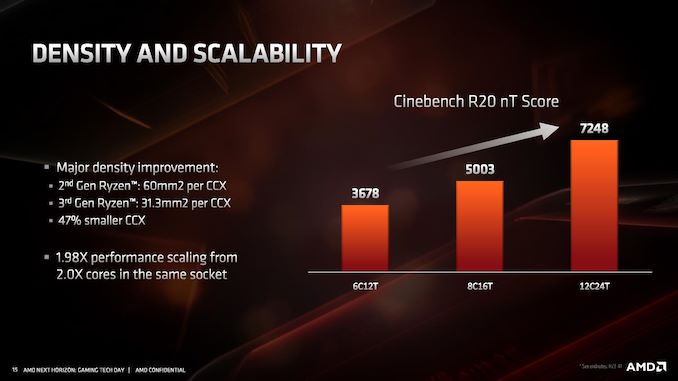
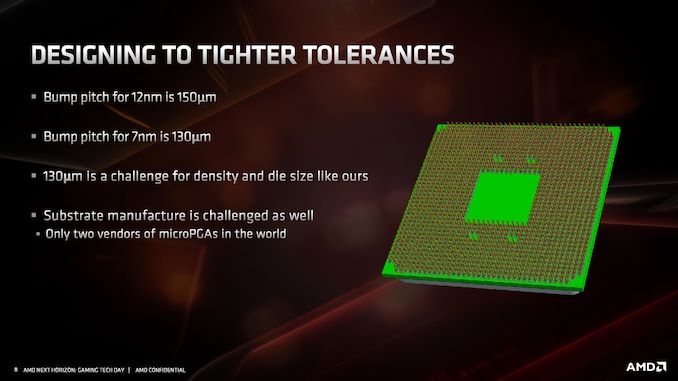
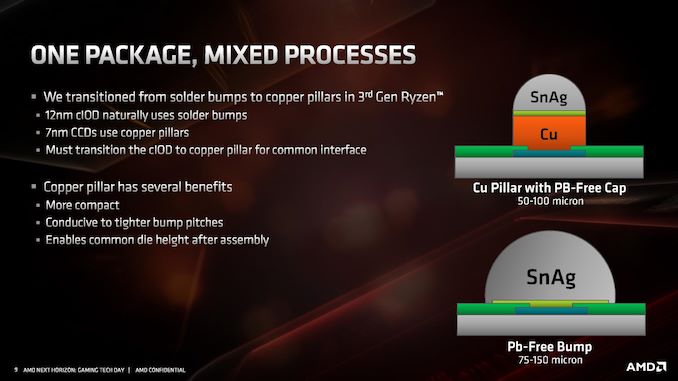
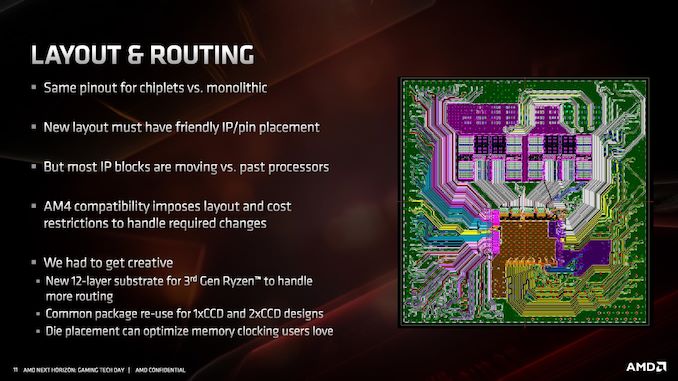
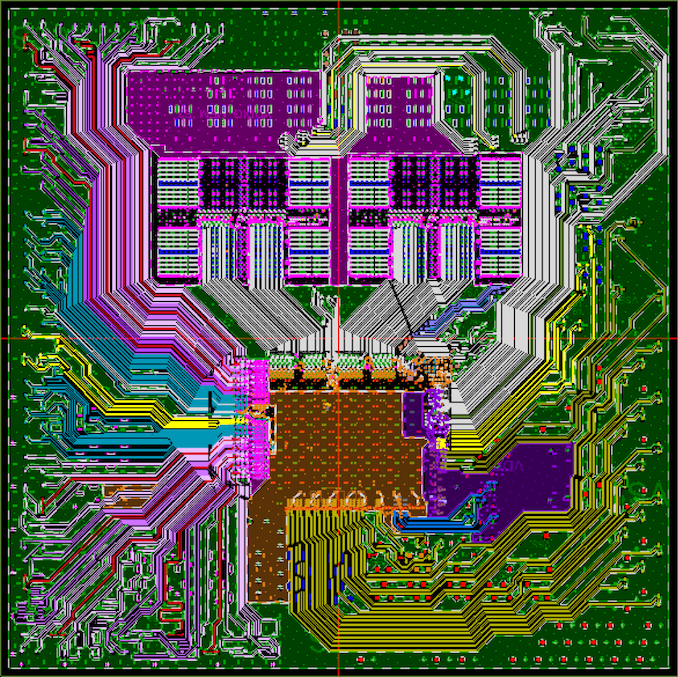








216 Comments
View All Comments
Walkeer - Thursday, June 13, 2019 - link
Superb analysis, thanks a lot @Ian! very excited to have the 3900x at home alreadyFreckledTrout - Thursday, June 13, 2019 - link
Reading over the Zen2 microarchitecture article Im left wondering if the Windows scheduler improvements are making use of a new unmentioned RDPID feature in Zen2 to determine where threads are placed?cooker358 - Thursday, June 13, 2019 - link
感谢分享!Gastec - Thursday, June 13, 2019 - link
I too am curious about the latencies, particularly between the chiplets. With the clock selection down to 2 ns and Windows' 10 hopefully improved thread allocation (filling a CCX, then the next one before jumping to the 2nd chiplet) latencies should be lower. We'll just have to wait for honest extensive testing and reviews to be done. You were not planning on buying these CPUs on release day or even worse, pre-ordering them, were you? :)jamescox - Sunday, June 16, 2019 - link
I expect the CCX to CCX latencies to be very good. There is no memory clock on the cpu chiplet, so the two on die CCX almost certainly communicate at cpu clock rather than memory clock as in Zen 1. It isn’t the same as Intel’s mesh network, but AMD’s solution will have better L3 latency within the CCX compared to Intel. Intel’s mesh network seems to be terrible for power consumption. Intel’s ring bus didn’t scale to enough cores. For their 18 core chip (if I am remembering right), they actually had 3 separate ring buses. The mesh network is obviously not workable across multiple chiplets, so it will be interesting to see what Intel does.For the chiplet to chiplet latency, they have more than doubled the infinity fabric serdes clock with the higher than PCIe 4.0 speeds. It seems that the internal IF clock is also around doubled. It was operating at actual memory clock in Sen 1 which was half the DDR rate. They seem to be running the internal IF clock the same as the DDR rate with the option to drop back to half DDR rate. So if you are running DDR 3200, the IF clock may actually be 3200 instead of 1600 as it would be in Zen 1. If you re overclocking to DDR 4000 or something, then it may need to drop down to 2000 for the internal IF clock. If this is the way it is set up, then they may have an option to explicitly set the divider, but it is probably going to not be stable past 3.7 GHz or so. The IO die is 14 nm global foundries, so that seems like a reasonable limitation.
The CCX to CCX latency should be less important as the OS and software is better optimized for the architecture. There was quite a few cases on Zen 1 of applications performing significantly better on Linux compared to windows due to the scheduler. Most applications can be optimized a bit for this architecture also. The problem is fine grained shared memory between threads on different CCX. It generally a good idea to reduce that anyway since locking can be detrimental to performance. With Zen 2, I think application level optimizations are probably going to be a lot less necessary anyway, but a lot of the early issues were probably caused by bad multi-threaded programming. This type of architecture isn’t going away. Intel can’t compete with Epyc 2 with a monolithic die. Epyc 2 will be around 1000 square mm of silicon total. Intel can’t scale core count without moving to something similar.
frshi - Friday, June 14, 2019 - link
@Ian Cutress What about 2x16GB sticks compared to 4x8GB? I remember Zen and Zen+ were kinda picky when using 4 sticks. Any change to that on Zen 2?RAINFIRE - Saturday, June 15, 2019 - link
Yeah - I'm curious. Can anyone speak to the (4 x 32GB) memory that Ryzen 3000 and x570 boards are supposed to support?Holliday75 - Wednesday, June 19, 2019 - link
IF reviewers have samples at this time they are under an NDA until July 7th. Only unconfirmed leaks can provide that kind of info and its super early. A lot of these types of issues won't be known until they go retail.AdrianMel - Sunday, June 16, 2019 - link
I would like these AMD chips to be used on laptops. Would be a breakthrough in terms of computing power, lower consumption. I think if a HBM2 or higher memory is integrated into the processor, I think it will double the computing power. Ar fi de studiat si o implementare a 2 porturi superiare thnic vechiului expresscard 54 in care sa putem introduce in laptopuri 2 placi videojamescox - Sunday, June 16, 2019 - link
Everyone keeps bringing up HBM for cpus as if it is magical in some manner. HBM can provide high bandwidth, but it is still DRAM. He latency isn’t that great, so it isn’t really that useful as a cpu cache. If you are trying to run AVX512 code across a bunch of CPU cores, then maybe you could use the bandwidth. If you have code that can use that level of parallelism, then it will almost certainly run much more efficiently on an actual gpu. I didn’t think that expanding AVX to 512-bits was a good idea. There isn’t too much difference from a cpu perspective between 1 512-bit instruction and 2 256-bit instructions. The registers are wider, but they can have many more smaller registers that are specified in the ISA by using existing register renaming techniques. At 14 nm, the 512-bit units seem to take too much space and consume too much power. They may be more easily doable in 7 nm or below eventually, but they may still have issues running at cpu core clocks. If you have to run it at half clock (which is about where gpus are vs. cpus) then you have lost the advantage of going double the width anyway. IMO, the AVX 512 instructions were Intel’s failed attempt (Xeon Phi seems to have been a disappointment) at making a cpu act like a gpu. They have basically given that up and are now designing an actual gpu.I went off in a bit of a tangent there, but HBM really isn’t that useful for a cpu cache. It isn’t going to be that low of latency; so it would not increase single thread performance much compared to stuff actually designed to be a low latency cache. The next generations form AMD May start using active silicon interposers, but I would doubt that they would use HBM. The interposer is most likely to be used in place of the IO die. They could place all of the large transistors needed for driving off die interfaces (reason why IO doesn’t scale well) in the active interposer. They could then stack 7 nm chips on top of the active interposer for the actual logic. Cache scales very well which is why AMD can do a $200 chip with 32 MB of L3 cache and a $500 chip with 64 MB of L3. Intel 14 nm chips top out at 38.5 MB, mostly for high priced Xeon chips. With an active interposer, they could, for example) make something like 4 or 8 memory controller chips with large SRAM caches on 7 nm while using the active interposer for the IO drivers. Many different configurations are possible with an active interposer, so it is hard to speculate. Placing HBM on the IO interposer, as the AdoredTV guy has speculated, doesn’t sound like a great idea. Two stacks of HBM deliver 512 GB/s, which would take around 10 IF links to transfer to the CPU chiplets. That would be a massive waste of power. If they do use HBM for cpu chiplets, you would want to connect it directly to the cpu chiplet; you would place the a cpu chiplet and HBM stack on the same interposer. That would have some latency advantage, but mostly for large systems like Epyc.